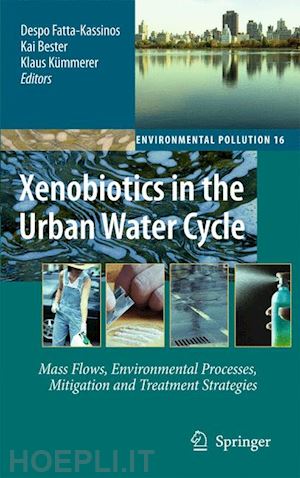
Questo prodotto usufruisce delle SPEDIZIONI GRATIS
selezionando l'opzione Corriere Veloce in fase di ordine.
Pagabile anche con Carta della cultura giovani e del merito, 18App Bonus Cultura e Carta del Docente
Despo Fatta-Kassinos received her Diploma in Chemical Engineering from the National Technical University of Athens, Greece and her M.Sc. in Environmental Management from the European Association for Environmental Management and Education (University of Athens, Greece – Joint Research Center, Ispra, Italy). She received her Ph.D. in Chemical Engineering from the National Technical University of Athens, Greece. She is a faculty member of the Department of Civil and Environmental Engineering of the University of Cyprus since 2003. She is the head of GAIA, Laboratory of Environmental Engineering where a number of scientific projects related to the treatment of xenobiotic compounds in aqueous matrices are being realised. She is a reviewer for several national and European funding bodies. Her principal research interests are in the field of water and wastewater treatment systems, monitoring of environmental pollution and environmental risk assessment. The main focus of her research is the development of advanced oxidation and other combined processes for the treatment of wastewater intended for reuse applications.
Kai Bester studied Chemistry and got his diploma (masters) degree from Hamburg University. He finished his PhD in Marine Environmental and Analytical Chemistry at Hamburg University 1995. Kai Bester worked as scientists at RWTH Aachen, EU Institute for Reference Materials and Measurements (EC-JRC-IRMM) Geel, Belgium and University of Duisburg Essen. He achieved Habilitation in 2005 at the university Duisburg Essen. He is currently working at Aalborg University section for Biotechnology, Chemistry and Environmental Engineering as well as Institute for Environmental Analytical Chemistry University Duisburg-Essen. His main focus is fate and effect of xenobiotic compounds (personal care compounds, bactericides, pharmaceuticals, biocides, flame retardants etc.) in aquatic ecosystems and technical applications.
Klaus Kümmererstudied chemistry in Würzburg and Tübingen. He received his Diploma in Chemistry and a PhD in Environmental and Analytical Chemistry from the University of Tübingen. He was head of the Chemistry Department at the Institute of Applied Ecology in Freiburg before he joined the University of Freiburg where he is currently head of the Section of Applied Environmental Research at the Department of Environmental Health Sciences of the Medical Centre Freiburg. In 1999 he became an Associate Professor in 2002 he was appointed Professor. He was visiting professor at the Case Western reserve University and has on going co-operations with researchers in Brazil, USA and several European countries. He was reviewer for several international funding bodies and is on board of several national and international committees and the editorial board of several scientific journals. He began research into xenobiotics in the water cycle in 1986 with a focus on pharmaceuticals, disinfectants and diagnostics since 1992. Other main fields of research are sustainable chemistry and sustainable pharmacy, benign chemicals and structure activity relationships











Il sito utilizza cookie ed altri strumenti di tracciamento che raccolgono informazioni dal dispositivo dell’utente. Oltre ai cookie tecnici ed analitici aggregati, strettamente necessari per il funzionamento di questo sito web, previo consenso dell’utente possono essere installati cookie di profilazione e marketing e cookie dei social media. Cliccando su “Accetto tutti i cookie” saranno attivate tutte le categorie di cookie. Per accettare solo deterninate categorie di cookie, cliccare invece su “Impostazioni cookie”. Chiudendo il banner o continuando a navigare saranno installati solo cookie tecnici. Per maggiori dettagli, consultare la Cookie Policy.